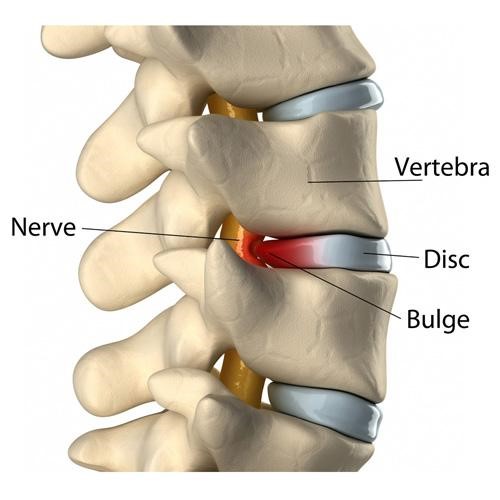The spine comprises 24 individual vertebrae stacked on top of each other. Flexible cushions called “discs” lie between each set of vertebrae. A disc is made up of two basic components. The inner disc, called the “nucleus” is like a ball of jelly about the size of a marble. This jelly is held in place by the outer part of the disc called the “annulus”, which is wrapped around the inner nucleus much like a ribbon wrapping around a finger. The term lumbar disc lesion means that the disc has been damaged.
Disc lesions start when the outer fibers of the disc become strained or frayed. If enough fibers become frayed, this can create a weakness, and when the disc is compressed, the outer fibers may “bulge” or “protrude” like a weak spot on an inner tube. If more fibers are damaged, the nucleus of the disc may “herniate” outward. Since the spinal cord and nerve roots lie directly behind the disc, bulges in the cervical spine that are accompanied by inflammation will probably cause neck pain that radiates into the shoulder or arm, and bulges in the lumbar spine that are accompanied by inflammation will probably create lower back pain that radiates into the buttock or the leg or foot. This condition is called sciatica. If the disc bulge is significant enough to create a mechanical compression of the nerve, you may also experience a loss of reflexes and weakness.
Cervical disc bulges are present, with no symptoms in over half of the adult population. The condition is slightly more common in men. Ninety percent of cervical disc problems occur at one of the two lower discs- C5/6 or C6/7. Certain occupations or activities may place you at greater risk, especially if you spend extended periods of time sitting, driving, or looking down. Improper sleep positions, frequent heavy lifting, and cigarette smoking may also increase your risk. Cervical disc bulges are most common between the ages of 40 and 50 and are less common in children and seniors.
Lumbar disc bulges are present with no symptoms in about 1/3 of the adult population. Another one-third of adults will experience pain from a lumbar disc in their lifetime. The condition is more common in men. Most lumbar disc problems occur at one of the two lowest discs-L5 or L4. Smokers and people who are inactive have a higher risk of lumbar disc problems. Certain occupations may place you at greater risk, especially if you spend extended periods of time sitting or driving. People who are tall or overweight have an increased risk of disc problems. Lumbar disc bulges are uncommon in children and are most common between the ages of 40 and 60.
Researchers have shown that both types of disc bulges, radiating arm pain, and sciatica may all be successfully managed with conservative care like the type we provide.
Credit: Information on this page provided by ChiroUp.

Dr. Matthew squeezed me in on short notice and took very good care of me. He was very thorough and didn’t just adjust me and let me walk out. Amazing experience here and the receptionist is a sweetheart.
Dr. Matt has done wonders for me and I recommend him highly – I can’t say enough good things about him. Dr. Matt and staff are good people and will take great care of you.
Very professional and in depth consultation. These people seem to genuinely care about people’s health and progress.
My family have used chiropractic and physical therapy services here and every one of us have had excellent outcomes. I wouldn’t go anywhere else these folks are as good as it gets.
I really love it here! They are very friendly and I feel Dr. Wilson is giving me great treatment! I also don’t feel pressured into coming back too frequently. The adjustments are great! Great office!
Dr. Matt and the entire staff have been GREAT! I went in for some issues I was having with my neck and back and Dr. Matt also helped me with some other issues I was having with my calf and shoulders that have made a HUGE improvement in my overall health and comfort.
I highly recommend using Dr. Matt!
